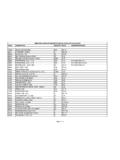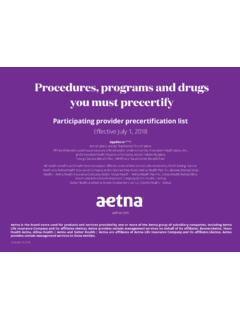Transcription of EPREX INTRAVENOUS & SUBCUTANEOUS INJECTION
1 1 EPREX (140701) DPIEPREX INTRAVENOUS & SUBCUTANEOUS INJECTION PRODUCT INFORMATION NAME OF THE MEDICINE epoetin alfa (rch) Its CAS Registry Number is 113427-24-0. Most common abbreviation: r-HuEPO Pharmacotherapeutic group: Anti -anaemic, ATC code: B03XA01. DESCRIPTION epoetin alfa is recombinant human erythropoietin (EPO). It is expressed in Chinese hamster ovary cells (rch) and has a 165 amino acid sequence identical to that of human urinary EPO; the two are indistinguishable on the basis of functional assays. The apparent molecular weight of erythropoietin is about 30,400 daltons. EPREX pre-filled syringes contain glycine, polysorbate 80, sodium chloride, sodium phosphate dibasic dihydrate, sodium phosphate monobasic, sodium citrate and water for injections. Pharmacology Erythropoietin (EPO) is a glycoprotein hormone produced primarily by the kidney in response to hypoxia and is the key regulator of red blood cell (RBC) production.
2 EPO is involved in all phases of erythroid development, and has its principal effect at the level of erythroid precursors. After EPO binds to its cell surface receptor, it activates signal transduction pathways that interfere with apoptosis and stimulates erythoid cell proliferation. Erythropoietin stimulates erythropoiesis in anaemic patients with chronic renal failure in whom the endogenous production of erythropoietin is impaired. Because of the length of time required for erythropoiesis several days for erythroid progenitors to mature and be released into the circulation a clinically significant increase in haemoglobin is usually not observed in less than two weeks and may require up to ten weeks in some patients. Erythropoiesis-stimulating agents ESAs are growth factors that primarily stimulate red cell production. Erythropoietin receptors may be expressed on the surface of a variety of tumour cells (see PRECAUTIONS Use in Cancer Patients).
3 Pharmacokinetics Measurement of epoetin alfa (rch) following INTRAVENOUS administration showed 10% excretion by the kidneys with the major routes of elimination not determined. After INTRAVENOUS administration the mean half lives in normal volunteers ranged from to hours and in patients with chronic renal failure from to hours. Following SUBCUTANEOUS INJECTION , serum levels are much 2 EPREX (140701) DPIlower than the levels achieved following IV INJECTION ; the levels increase slowly and reach a peak between 12 and 18 hours post-dose. The peak is always well below the peak achieved using the IV route (approximately 1/20th of the value). Following SUBCUTANEOUS INJECTION , erythropoietin serum levels remain elevated above baseline for about 72 hours. There is no accumulation when thrice weekly dosing is used: the levels remain the same, whether they are determined 24 hours after the first INJECTION or 24 hours after the last INJECTION .
4 The half-life is difficult to evaluate for the SUBCUTANEOUS route and is estimated about 24 hours. The bioavailability of SUBCUTANEOUS injectable erythropoietin is much lower than that of the INTRAVENOUS drug: approximately 20-30%. No information is available in the young and in the elderly. Due to decreased metabolism patients with hepatic dysfunction may have increased erythropoiesis with EPREX . CLINICAL TRIALS EPREX has been studied in a series of placebo-controlled, double-blind trials in a total of 131 anaemic cancer patients. Within this group, 72 patients were treated with concomitant noncisplatin-containing chemotherapy regimens and 59 patients were treated with concomitant cisplatin-containing chemotherapy regimens. Patients were randomised to EPREX 150 IU/kg or placebo subcutaneously (three times a week) for 12 weeks. EPREX therapy was associated with a significantly (p< ) greater haematocrit response than in the corresponding placebo-treated patients (see TABLE 1).
5 Table 1. Haematocrit (%): Mean change from baseline to final value STUDY EPREX PLACEBO Chemotherapy Cisplatin * Significantly higher in EPREX patients than in placebo patients (p < ) In the two types of chemotherapy studies [utilising an EPREX dose of 150 IU/kg three times weekly] the mean number of units of blood transfused per patient after the first month of therapy was significantly (p < ) lower in patients treated with EPREX ( units in months 2, 3) than in corresponding placebo-treated patients ( units in months 2, 3). Moreover, the proportion of patients transfused during months 2 and 3 of therapy combined was significantly (p < ) lower in the patients treated with EPREX than in the corresponding placebo-treated patients (22% versus 43%). Comparable intensity of chemotherapy in the EPREX and placebo groups in the chemotherapy trials was suggested by a similar area under the neutrophil time curve in patients treated with EPREX and placebo-treated patients as well as by a similar proportion of patients in groups treated with EPREX and placebo-treated groups whose absolute neutrophil counts fell below 1,000 cells/microlitre.
6 Available evidence suggests that patients with lymphoid and solid cancers respond equivalently to EPREX therapy and that patients with or without tumour infiltration of the bone marrow respond equivalently to EPREX therapy. Efficacy and safety of EPREX in the prevention and treatment of anaemia of cancer has not been demonstrated in children. epoetin alfa has been studied in a placebo-controlled, double-blind trial enrolling 316 patients scheduled for major, elective orthopaedic hip or knee surgery who were expected to require 2 units of blood. Patients were randomly assigned to receive 300 IU/kg epoetin alfa , 100 IU/kg epoetin alfa or placebo by SUBCUTANEOUS INJECTION for 10 days before surgery, on the day of surgery, and for four days after surgery. All patients received oral iron and a low dose postoperative warfarin regimen. Treatment with epoetin alfa 300 IU/kg significantly (p= ) reduced the risk of allogeneic transfusion in patients with a pretreatment haemoglobin of > 100 to 130 g/L; 5/31 (16%) of 3 EPREX (140701) DPIE poetin alfa 300 IU/kg, 6/26 (23%) of epoetin alfa 100 IU/kg and 13/29 (45%) of placebo-treated patients were transfused.
7 In the >100 to 130 g/L pre-treatment stratum, the mean number of units transfused per epoetin alfa treated patient ( units blood for 300 IU/kg, units blood for 100 IU/kg) was less than the mean transfused per placebo-treated patient ( units) (overall p= ). In addition, mean haemoglobin, haematocrit and reticulocyte counts increased significantly during the pre-surgery period in epoetin alfa treated patients. epoetin alfa was also studied in an open label, parallel-group trial enrolling 145 subjects with a pretreatment haemoglobin level of 100 to 130 g/L who were scheduled for major orthopaedic hip or knee surgery and who were not participating in an autologous program. Subjects were randomly assigned to receive one of two SUBCUTANEOUS dosing regimens of epoetin alfa (600 IU/kg once weekly for three weeks prior to surgery and on the day of surgery or 300 IU/kg once daily for 10 days prior to surgery, on the day of surgery and for four days after surgery).
8 All subjects received oral iron and appropriate pharmacologic anticoagulation therapy. From pretreatment to pre-surgery, the mean increase in haemoglobin in 600 IU/kg weekly group ( g/L) was greater than observed in the 300 IU/kg daily group. The erythropoietic response observed in both treatment groups resulted in similar transfusion rates [11/169 (16%) in the 600 IU/kg weekly group and 14/71 (20%) in the 300 IU/kg daily group]. The mean number of units transfused per subject was approximately units in both treatment groups. Using linear logistic models it can be calculated that for a patient with an entry haemoglobin level of 100 g/L, use of 300 IU/kg daily or 600 IU/kg weekly would reduce the probability of transfusion to about 38%, compared to 58% in the same patient receiving a 100 IU/kg daily regimen, or 81% in a patient given no EPREX therapy. Similarly, at a higher entry haemoglobin of 120 g/L, the 300 IU/kg daily or 600 IU/kg weekly regimens would reduce the probability of transfusion to about 18%, compared to 35% in the same patient receiving 100 IU/kg daily, or 61% in a patient receiving no EPREX .
9 In autologous blood donation, a double blind study was conducted in 204 patients scheduled to undergo elective orthopaedic surgery with haematocrits 39% and no underlying anaemia due to iron deficiency. On average, patients treated with EPREX 600 IU/kg twice weekly for three weeks were able to pre-deposit significantly more units of blood ( units) than placebo treated patients ( units) (p< ). Also, significantly more patients treated with EPREX (p< ) were able to pre-deposit between 3 and 6 units, inclusively, of autologous blood than the corresponding placebo treated patients. Virtually all (98%) of EPREX treated patients pre-deposited 3 or more units, compared with 69% of placebo treated patients. While 37% of placebo patients were able to pre-deposit 4 or 5 units, 81% of EPREX patients pre-deposited 4 or more units. Among the evaluable patients, fewer patients who received EPREX required allogeneic transfusions ( ) than placebo patients (31%).
10 In a second placebo controlled study, 55 patients with low haematocrits were enrolled 2:2:1 to receive EPREX 600 IU/kg, EPREX 300 IU/kg or placebo twice weekly for three weeks. A significantly greater amount of autologous blood (p< ) was donated by the EPREX treated patients ( vs vs units). Likewise 84, 79 and 11% of patients were able to donate four or more units over the three-week study. INDICATIONS EPREX is indicated for the treatment of patients with symptomatic or transfusion requiring anaemia associated with chronic renal failure to improve their quality of life by improving energy 4 EPREX (140701) DPIlevels, exercise performance, fatigue and sleep patterns and by reducing the need for blood transfusions. EPREX is also indicated for the treatment of anaemia and reduction of transfusion in patients with non-myeloid malignancies where anaemia develops as a result of concomitantly administered chemotherapy EPREX is also indicated in adult patients with mild-to-moderate anaemia (haemoglobin > 100 to 130 g/L) scheduled for elective surgery with an expected moderate blood loss (2 4 units or 900 to 1800 mL) to reduce exposure to allogeneic blood transfusion and to facilitate erythropoietic recovery.





